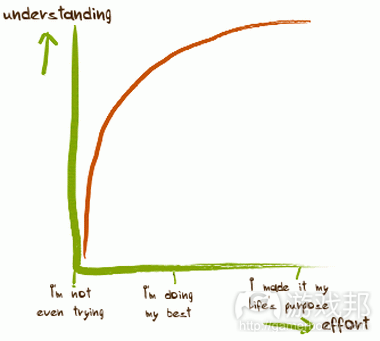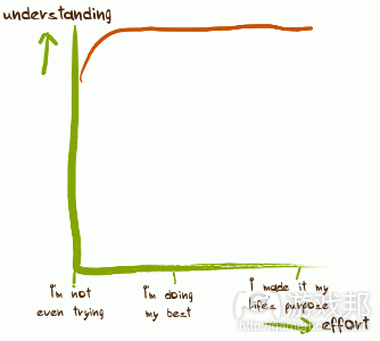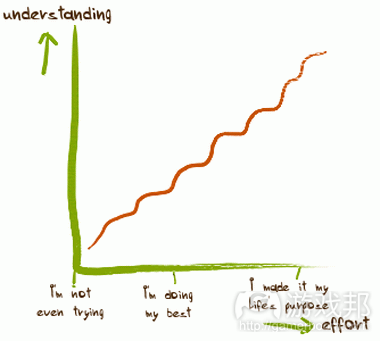阐述休闲游戏设计中的学习曲线
作者:William
若关于游戏你仅限于体验,那么认为游戏学习方式根植于游戏本身也就情有可原;这不过是根据游戏呈现方式所得出的结论。作为游戏设计师,你应意识到学习曲线也是需要设计的内容。游戏学习曲线在新玩家如何认知游戏方面影响很大。
虽然我猜想你应该能够轻松想象学习曲线的样子,但我还是决定绘制一幅,因为在我们把握其精髓前,有些内容还是需要先理清。
问题:学习曲线是陡峭还是平缓?
上图显示,投入学习规则的努力越多,规则的理解效果就越好。玩家的目标就是完全理解游戏规则。就像你从图中看到的,完全理解规则需付出很大努力。所以,这就是我们所说的陡峭学习曲线。下图呈现的是平缓学习曲线。
在此图中,理解耗费更少努力,所以这就是我们所说的平缓学习曲线。奇怪的是,若观看图表,你会发现第一幅呈陡峭趋势,第二幅呈平缓趋势。我可以通过改变轴线解决此问题,这似乎有违直觉。我们称作陡峭曲线的过程绘制出来其实是个平缓曲线。很奇怪,是吧?不管怎样,我们先回到最初话题。
通常来说,平缓曲线优于陡峭曲线,特别是就休闲游戏而言。当然也有些玩家追求挑战,但我们最好还是将游戏设计成挑战活动,而非学习过程(游戏邦注:所以,若我们能够把陡峭学习曲线变成平缓形式,将收获良多)。
提供指南
你很难设计缺乏规则的游戏,若存在规则,玩家就得学习。策略之一就是加快整个学习过程。换而言之,你将告诉玩家:“这些是规则,你需掌握,掌握之后你就能开始体验”。这是棋盘游戏遵循的路线。你需阅读手册,尽可能记住所有规则,然后才能进行体验。让玩家向其他玩家解释游戏规则,并不会令过程变得更有趣。
经常发生的情况是,你阅读手册前1/3,浏览中间的1/3,然后完全跳过最后部分。你把手册弃置一旁,然后发表“让我们看看游戏如何运作”之类的话语。但在棋盘游戏设计师开始抱怨前,让我告诉你电脑游戏玩家是如何对待说明手册。“手册?有手册?”现在,这是个问题。
那么,电脑游戏设计师是怎么做?他们只是把手册融入游戏中,将其称作指南。这成为游戏规则学习问题最杰出的解决方案(游戏邦注:这同时也是最不讲究的,但这里我们不加以讨论)。指南从根本上说,旨在加快学习过程。
注意时间不是X轴,努力才是。指南将快速向玩家介绍规则,但这并不意味着玩家学习规则无需付出较大努力。设计指南需牢记:你的目标是简化学习过程,而不是加快整个过程。
借助常识
有些游戏,你无需学习其规则就能够进行体验:你已知晓些游戏的规则。规则非常显然无需进行陈述,但你能够借助此元素充分发挥优势。
多数人置身电脑前都能够立即开始体验《Solitaire》。这不是因为规则非常明显,而是因为他们已经知晓规则。不是所有人都想制作另一《Solitaire》,所以若你未将现实游戏植入虚拟世界,未复制另一电脑游戏,此信息又有何用处?其实用处很多。
即便你没有复制另一款游戏的全部规则,你的规则还是会和众所周知的游戏存在共同之处。例如,在多数纸牌游戏中,玩家可以按数字大小排列纸牌,形成牌组(游戏邦注:例如你可以把6放在7上面,把10放在J上面,把王后放在王上面)。所以若你设计新的纸牌游戏,也可以使用相同规则,这能够便于玩家理解。当然纸牌顺序已经是个标准。就像大家都知道王胜过王后,所以你在设计中最好也遵守这个规则。
几乎所有游戏都有众所周知的规则。多数第一人称射击游戏玩家都知道射击枪管会出现爆炸,而射击木箱不会(除非你使用火箭发射器)。这规则相当随意,但大家都知道,作为设计师,你也需明白这点。因此学习曲线不会变得更平缓,而是变得更陡峭。玩家将在开始体验前就把握你游戏的规则。
你可以通过制作玩家凭直觉就能操作的游戏,创造类似效果。当你开始体验《吃豆人》游戏时,你会看到5个角色,其中只有一个站着不动,所以这多半就是你所扮演的角色。若你处在迷宫中,你就能够在廊道中行走,因为这就是迷宫的运作方式。玩家通常无法穿过墙体。当经过药丸时发出愉快音效说明吃下药丸是件好事。由于幽灵非常恐怖,所以你最好还是绕道而行。现在你知道为什么《吃豆人》无需提供游戏指南。
拖延学习曲线
即便采用上述策略,有些游戏还是不易把握。若你所设计的游戏遇到此问题,我建议你采取下述策略。
这是否优于先前的曲线?或许没有,因为现在玩家需耗费很长时间才能掌握游戏规则。但想想玩家的游戏目标。她并不想尽快掌握规则。就有些游戏而言,特别是那些颇有难度的体验,玩家完全有可能在掌握所有规则前体验和享受游戏。多数桌面弹球游戏都有系列桌面规则。遵循这些规则,玩家将能够完成特定任务,获得某些积分。但若你尚不知其中规则,单通过连续弹击小球也能够获得许多乐趣(游戏邦注:剩余规则将会逐步通过矩阵板向玩家呈现)。
有时若玩家无需规则,那你可以设计完全跳过规则的游戏。若你设计一款玩家非魔力玩家的角色扮演游戏,你就无需向玩家解释如何使用魔法。此外,在有些游戏中,你无需完全理解所有规则便能够体验和完成任务。我在尚未把握所有《文明》游戏规则前,就已反复体验这款游戏多次,我曾经连续几个小时玩这款游戏。
牢记目标
我之所以再次重复是因为我觉得这点很重要:玩家并不想尽快掌握规则,他们希望尽快体验游戏。只要你在设计游戏时牢记这点,那就不会有错。
游戏邦注:原文发布于2006年1月18日,文章叙述以当时为背景。(本文为游戏邦/gamerboom.com编译,如需转载请联系:游戏邦)
Learning the rules
If all you do with games is play them, you may be forgiven for thinking that the way you learn a game is inherent to the game; that is just follows from the way the game is. As a game designer, however, you should realize that the learning experience is something you also can – and should – design. The learning curve of a game has a huge impact on how new players perceive that game.
Although, I suspect you can readily imagine what a learning curve looks like, I’ll draw one for you, because there is something I’d like to point out before we get to the good stuff.
Question: is this learning curve steep or shallow?
What the above graph shows, is that the more effort you put into learning the rules, the better your understanding of the rules will be. What you are aiming for as a player, is total understanding of the rules. As you can see in the graph, it takes quite a bit of effort to understand the rules completely. So, this is what we call a steep learning curve. The next graph shows a shallow learning curve.
In this picture, understanding comes after a lot less effort, so this is what we call a shallow learning curve. The strange thing is, if you look at the pictures, the second graph is the steep one and the first graph is the shallow one. I could solve this by swapping the axes, but that seems counter-intuitive. What we usually call a steep learning curve is actually a shallow one when you draw it and vice versa. Weird, isn’t it? Anyway, back to the original topic.
In general, a shallow learning curve is better than a steep one, especially with casual games. Of course, there are players who are looking for a challenge, but it’s usually a good decision to make playing the game the challenge and not learning the game. So, it would be valuable if we could turn a steep learning curve into a shallow one.
Providing a tutorial
Try as you might, you can’t design a game that has no rules, and if there are rules, the player will have to learn them. One strategy is to just get it over with. In other words, you’ll tell the player: “These are the rules. Learn them. When you’re done, you can start playing.” This is the path board games take. You have to read through the manual and memorize all the rules as best you can before you can even begin. The fact that you then have to explain what you learned to all the other players, doesn’t make this process more enjoyable.
What often happens in these cases, is that you read a third of the manual, skim the next third and skip the last part entirely. You throw the manual aside and say something like “we’ll just see how it goes”. But before you board game designers start complaining about this, let me tell you how players of computer games treat the manual. “Manual? There was a manual?” Now, that’s a problem.
So, what’s a computer game designer to do? Well, just put the manual into the game and call it a tutorial. This has become the most prominent solution to the problem of learning the game rules. (It’s also the least elegant, but that’s a topic for another time.) A tutorial is basically an attempt to speed up the learning process.
Note that time isn’t on the x-axis, effort is. The tutorial will introduce the rules to the player (or the player to the rules) quickly, but that doesn’t necessarilly mean that learning the rules doesn’t require a lot of effort on the player’s part. Remember this when you’re designing a tutorial: your goal is to make it easier to learn the game, not (necessarilly) faster.
Using common knowledge
There are games for which you don’t have to learn the rules in order to be able to play them: games to which you already know the rules. This seems a bit too obvious to mention, but you can use this principal to your advantage.
Most people you put behind a computer can start playing Solitaire right away (well, after they stop talking into the mouse, that is). That’s not because the rules are completely obvious, but because they already know the rules. Not all of us want to create Yet Another Solitaire, so what good is this information if you’re not adapting a real world game to the virtual world and you’re not cloning another computer game? A lot, actually.
Even if you’re not copying the entire ruleset from another game, you might still have elements in common with well-known games. For example, in most games of solitaire, you can build groups by putting a card on another card that is one higher in rank, i.e. you can put a six on a seven, a ten on a jack and a queen on a king. So, if you’re designing a new game of solitaire, you can use that same rule and it will be easy for players to understand. Of course, the ranks of the cards is also an example of something that is pretty standard. Just about everybody know that a king is higher in rank than a queen, so you’d be wise to adher to that rule in your design.
Just about every game genre has some well-known rules. Most players of first-person shooters know that shooting a barrel will result in an explosion, while shooting a crate will not (unless you use the rocket launcher, of course). That rule is quite arbitrary, but players know it and, as a designer, you should make use of that. The result is that the learning curve doesn’t just get shallower, it actually start higher up. The player will have an understanding about the rules of your game even before she starts playing.
You can create a similar effect by presenting your game in such a way that the player intuitively knows what to do. When you start Pac-Man, you see five characters and only one of them is standing still, so the chances are, that’s your avatar. The fact that your in a maze, suggests that you can move down through corridors, because that’s how our mazes usually work. And moving through walls is probably not an option. The happy sound you hear when you pass over a pill, means that eating pills is a good thing. And since ghosts are scary, you’d better run the other way. Now you know why Pac Man doesn’t come with a tutorial.
Dragging out the learning curve
Even with the above strategies, some games are still really hard to learn. If you face such a challenge with the game you are designing, then I suggest you take the following approach.
Does that seem better than the previous curves? Maybe not, because now it takes a very long time before the player knows all the rules. But think about what the player’s goal is. She doesn’t want to know the rules as quickly as possible, she wants to play the game as quickly as possible. (Yes, I know that I said before that your goal as a player is to have a total understanding of the game rules. So, I lied, okay? Deal with it. And yes, I’m telling the truth now. Really.) With some games, especially complex ones, it’s very well possible to start playing and enjoying the game before you understand all the rules. Most pinball tables have a set of table rules. Following these rules allows you to complete certain tasks and score more points. But, even if you don’t know the table rules yet, you can still have a lot of fun just knocking the ball around. The rest of the rules will be pointed out to you over time on the matrix board.
Sometimes you can design a game to skip an entire section of the ruleset if the player doesn’t need it. If you are designing a role-playing game where the player can decide not to be a magic user, then you don’t have to explain to her how to cast spells. Also, there are games you can enjoy and finish without completely understanding all the rules. I played many games of Civilization before I knew all the rules (hey, I was seven years old, okay!), but I did play the game for hours on end.
Remember the goal
I’ll repeat this, because I think it’s important: the player doesn’t want to learn the rules as quickly as possible, she wants to play the game as quickly as possible. As long as you design your games with that in mind, you’ll be okay. (Source:casualgamedesign)
下一篇:游戏设计应避免出现正反馈现象












































 闽公网安备35020302001549号
闽公网安备35020302001549号